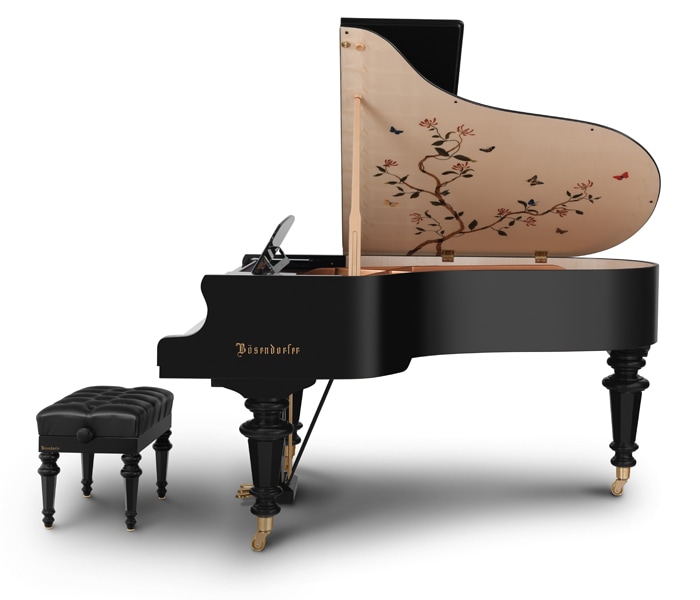The piano stands out for its dynamic range and expressiveness. This instrument’s versatility spans genres, from classical to jazz to pop.
The piano, a timeless cornerstone of musical performance and composition, captivates both players and listeners. With its intricate system of strings and hammers, it produces a wide array of pitches, allowing for lush harmonies and intricate melodies. The tactile nature of a keyboard fosters a direct connection between the musician and their music, offering an unparalleled level of control and nuance.
Pianos serve as both solo instruments and ensemble collaborators, making them quintessential in concerts, studios, and homes. Their unique ability to simulate an entire orchestra opens up endless creative possibilities, forging a special bond between the piano, its music, and its audience. Musicians treasure the piano for this unique blend of technical prowess and emotional capacity.

Credit: usa.yamaha.com
The Unique Allure Of The Piano
Imagine a musical instrument that can whisper soft melodies and shout dramatic chords. That instrument is the piano. Its black and white keys hold the power to stir emotions. The piano is special because it blends storytelling with melody. It’s an orchestra in a box!
Historical Significance In Music
The piano’s journey through time is fascinating. It has been the heart of music for centuries. Composers like Mozart and Beethoven created masterpieces on the piano. These pieces still touch our hearts today.
- 1700s: The piano appears in Europe.
- 1800s: It gains popularity. It becomes better and louder.
- Today: Everywhere in music, we find the piano’s influence.
Versatility Across Genres
Any style of music finds a friend in the piano. It doesn’t just belong to classical music. The piano is the backbone for jazz, rock, pop, and more. Here’s a snapshot:
| Genre | Examples |
|---|---|
| Classical | Concertos, Sonatas |
| Jazz | Improvisation, Swing |
| Rock/Pop | Ballads, Anthems |
Anatomy Of The Piano
The piano charms with its harmonious presence, and it’s a treasure trove of music and mechanics.
Peek beneath its polished exterior to discover a world of intricate parts. Let’s delve into the majesty of the piano’s anatomy.
Complex Internal Mechanics
The interior of a piano reveals a maze of precision. Each press of a key sets off a ballet of components. Here’s a glimpse:
- Hammers strike the strings, creating sound.
- The action is the mechanism that connects keys to hammers.
- Dampers rest on strings to stop vibrations when needed.
In grand pianos, the action is a feat of engineering. It must be responsive, yet powerful. Every piece works in perfect harmony.
Range And Octaves
Every piano keyboard boasts a range of notes, from deep lows to soaring highs:
| Section | Notes | Octaves |
|---|---|---|
| Bass | A0 to C4 | 2-3 |
| Tenor: | C4 to F5 | 1-2 |
| Treble | F5 to C8 | 3-4 |
Pianos usually have 88 keys, with 52 white and 36 black keys. Each group of 12 keys forms an octave.
The piano’s range allows it to mimic an entire orchestra. This makes it special among instruments.
Pianists: Masters Of Coordination
The world of music marvels at the piano, a complex instrument. Pianists are the agile conductors of this harmony. Their coordination skills stand out as they blend melody with rhythm.
Hand-eye Coordination
Playing the piano demands precise hand-eye coordination. As their eyes scan the music notes, pianists’ hands move swiftly over the keys. Their fingers press the right keys at the perfect moment, creating enchanting tunes.
- Reading music sheets while playing.
- Hands move smoothly across piano keys.
- Fingers make quick, accurate strikes.
Their coordination allows them to play complex melodies with grace. It’s like their hands dance on the keys!
Pedal Techniques
Along with their hands, pianists also master the use of pedals. The pedals are foot-operated levers at the base of the piano. They change the instrument’s sound in subtle, yet powerful ways.
| Pedal | Function |
|---|---|
| Sustain Pedal | Lengthens the notes |
| Soft Pedal | Reduces the volume and softens the tone |
| Sostenuto Pedal | Sustains selected notes |
Coordinating these pedal techniques with hand movements is essential. This skill differentiates good pianists from great ones. They create moods and emotions through their footwork.
From classical sonatas to jazz improvisations, pianists prove their coordination prowess. This unique blend of skills opens a world of musical possibilities. Indeed, pianists truly are masters of coordination.

Credit: www.allisonacademy.com
The Piano In Music Education
The piano stands unique and distinguished in music education. Its comprehensive range, dynamic versatility, and the direct relationship between keys and notes make it an exceptional tool for learning. Both instructors and students favor the piano for educational purposes, laying a strong foundation for a lifetime of musical enjoyment and understanding.
First Instrument For Beginners
Why do many start their musical journey with the piano? Its layout is intuitive and visually logical. Simple melodies and basic chords are accessible to novices. This ease of starting fosters a positive initial experience in music learning.
- 1-to-1 key-to-note relationship
- Immediate auditory feedback
- Builds finger strength and coordination
Theory And Notation Introduction
Understanding music theory becomes naturally easier with a piano. It graphically represents the music staff on its keyboard. Learners can visualize intervals, scales, and chords directly. Reading music is akin to decoding a map while pressing the keys.
| Concept | Representation on Piano |
|---|---|
| Scales | Sequential white and black keys |
| Chords | Groups of keys played simultaneously |
| Rhythms | Repeating patterns emphasize beat |
Innovations And Evolutions
It’s the blend of history and technology that makes the piano truly special. It stands as a symbol of musical evolution. Each leap in design and innovation has reshaped the way we create music.
From Harpsichord To Modern Grand
The piano’s journey began with the harpsichord. Over centuries, it transformed into today’s modern grand piano. Let’s explore key milestones:
- Cristofori’s creation: Around 1700, Bartolomeo Cristofori invented the first piano.
- Hammer mechanics: The piano used hammers to strike strings, unlike the plucked strings of a harpsichord.
- Dynamic expression: Musicians could now change volume and expression through touch.
Pianos have grown larger and louder with stronger frames and better strings. They offer rich sound that fills concert halls.
Digital Pianos And Keyboards
The digital era introduced keyboards and digital pianos. These instruments mimic acoustic pianos yet offer modern advantages:
| Feature | Advantage |
|---|---|
| Portability | Light and easy to move |
| Volume Control | Play at any volume, even with headphones |
| Variety of Sounds | Access to numerous instrument sounds |
| Recording Capability | Record and edit music easily |
Professional musicians and beginners both love these features. They make music accessible to everyone. Innovations like weighted keys make digital pianos feel like acoustic pianos.
The Piano In Concert Settings
The piano commands a unique presence on the stage. It serves as the heartbeat of many musical assemblies and shines just as brightly when displayed solo. Its versatility allows it to transition effortlessly between front-and-center performances and collaborative concert settings. Let’s unfurl the magic of the piano as it takes on different roles beneath the spotlight.
Solo And Ensemble Roles
The grandeur of a solo piano performance can capture any audience. The pianist leads an intimate conversation between the keys and the listeners. In contrast, ensemble performances showcase the piano’s ability to collaborate. Here, the piano can support the melody or even drive the harmonic foundation.
- Solo spotlights skill and emotional depth of the pianist.
- Ensembles highlight synergy with instruments and voices.
In ensembles, the role of the piano is multifaceted:
| Role | Description |
|---|---|
| Accompaniment | Supports other instruments with harmony and rhythm. |
| Rhythmic Backbone | Dictates the tempo and keeps the ensemble together. |
| Melodic Lead | Carries the main theme within a larger group. |
Iconic Performances
Certain piano performances become legendary, leaving a lasting impact on listeners and fellow musicians alike. Fine examples include Lang Lang’s mesmerizing renditions and Evgeny Kissin’s powerful interpretations. These performances transcend time, echoing the profound effect the piano holds within concert settings.
- Lang Lang’s concerts fuse emotion with technical proficiency.
- Evgeny Kissin captivates with boldness and finesse.
Iconic performances feature unique elements:
| Element | Characteristic |
|---|---|
| Technical Mastery | Flawless execution of complex compositions. |
| Emotional Connection | Conveys deep feelings to the audience. |
| Innovative Interpretations | Presents fresh perspectives on classic pieces. |

Credit: steinway.co.uk
What Special Features of a Piano Make it Accessible for Blind Individuals to Learn?
The special features of a piano make learning piano as a blind individual accessible. The tactile layout of the keys and pedals allows for easy navigation without the need for visual cues. Additionally, the consistent layout and sound of the keys aid in memorization and learning through touch and sound.
Frequently Asked Questions Of What Is Special About Piano
What Makes A Piano So Special?
A piano’s unique appeal lies in its versatility and range, offering both melody and harmony. It creates a rich sound palette, serving as a solo instrument and enabler of group performances, beloved in numerous musical genres.
What Is So Amazing About Piano?
The piano’s versatility and range are astounding, accommodating countless musical genres. Its ability to convey a wide spectrum of emotions makes it exceptional, appealing to performers and audiences alike.
What Is Said To Be Special About The Piano?
The piano stands out for its dynamic range and expressive potential. Its unique ability to produce varied tones makes it versatile for numerous musical genres.
What Are 5 Interesting Facts About Piano?
The piano has 88 keys, spanning seven octaves plus a minor third. Originally, pianos were named “pianoforte” for their soft (piano) and loud (forte) volume capabilities. Pianos didn’t become standard household items until the 18th century. Over 12,000 parts comprise a typical piano.
Legendary composer Beethoven was a pivotal figure in the piano’s history.
Conclusion
Exploring the piano’s magic reveals a world of expressive potential. From its intricate mechanics to its cultural impact, the piano stands as a testament to human creativity. Whether you’re a seasoned performer or a curious listener, the piano has something special to offer.
Embrace its keys, and let the music speak.
{ “@context”: “https://schema.org”, “@type”: “FAQPage”, “mainEntity”: [ { “@type”: “Question”, “name”: “What makes a piano so special?”, “acceptedAnswer”: { “@type”: “Answer”, “text”: “A piano’s unique appeal lies in its versatility and range, offering both melody and harmony. It creates a rich sound palette, serving as a solo instrument and enabler of group performances, beloved in numerous musical genres.” } } , { “@type”: “Question”, “name”: “What is so amazing about piano?”, “acceptedAnswer”: { “@type”: “Answer”, “text”: “The piano’s versatility and range are astounding, accommodating countless musical genres. Its ability to convey a wide spectrum of emotions makes it exceptional, appealing to performers and audiences alike.” } } , { “@type”: “Question”, “name”: “What is said to be special about the piano?”, “acceptedAnswer”: { “@type”: “Answer”, “text”: “The piano stands out for its dynamic range and expressive potential. Its unique ability to produce varied tones makes it versatile for numerous musical genres.” } } , { “@type”: “Question”, “name”: “What are 5 interesting facts about piano?”, “acceptedAnswer”: { “@type”: “Answer”, “text”: “The piano has 88 keys, spanning seven octaves plus a minor third. Originally, pianos were named \”pianoforte\” for their soft (piano) and loud (forte) volume capabilities. Pianos didn’t become standard household items until the 18th century. Over 12,000 parts comprise a typical piano. Legendary composer Beethoven was a pivotal figure in the piano’s history.” } } ] }